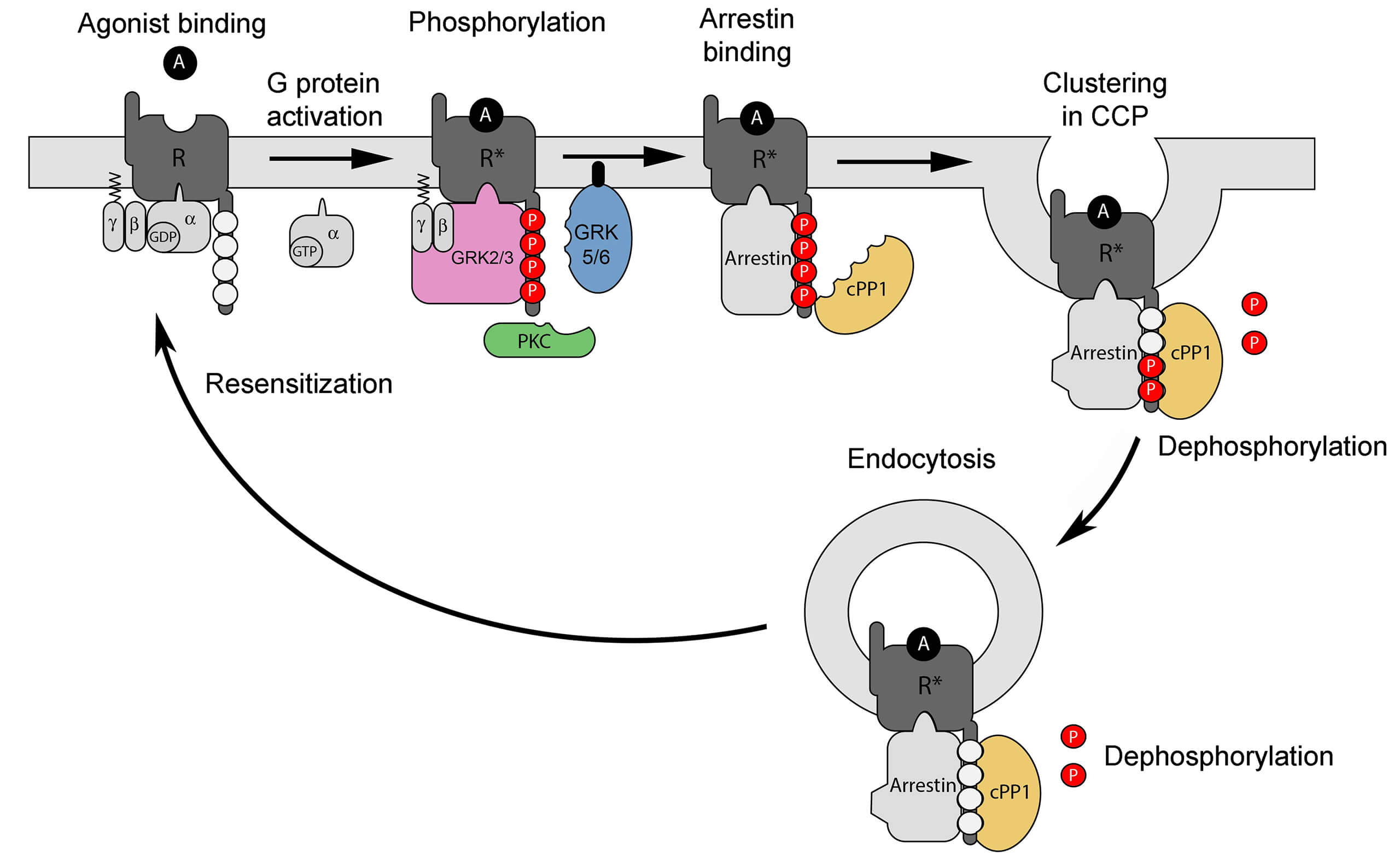No results were found for the filter!
NEW
 pT408/pT409-OX2 (phospho-Orexin Receptor 2...
pT408/pT409-OX2 (phospho-Orexin Receptor 2... Threonine408/Threonine409 (T408/T409) is a major phosphorylation site of the Orexin receptor 2 (OX2). The pT408/pT409-OX2 antibody detects phosphorylation in response to high-efficacy agonists. T408/T409 phosphorylation is a key...
CHF400.00 *
NEW
 pT401/pS403-OX2 (phospho-Orexin Receptor 2...
pT401/pS403-OX2 (phospho-Orexin Receptor 2... Threonine401/Serine403 (T401/S403) is a major phosphorylation site of the Orexin receptor 2 (OX2). The pT401/pS403-OX2 antibody detects phosphorylation in response to high-efficacy agonists. T401/S403 phosphorylation is a key regulator...
CHF400.00 *
NEW
 pS399/pS401-OX1 (phospho-Orexin Receptor 1...
pS399/pS401-OX1 (phospho-Orexin Receptor 1... Serine399/Serine401 (S399/S401) is a major phosphorylation site of the Orexin receptor 1 (OX1). The pS399/pS401-OX1 antibody detects phosphorylation in response to high-efficacy agonists. S399/S401 phosphorylation is a key regulator of...
CHF400.00 *
NEW
 pS393/pS394-OX1 (phospho-Orexin Receptor 1...
pS393/pS394-OX1 (phospho-Orexin Receptor 1... Serine393/Serine394 (S393/S394) is a major phosphorylation site of the Orexin receptor 1 (OX1). The pS393/pS394-OX1 antibody detects phosphorylation in response to high-efficacy agonists. S393/S394 phosphorylation is a key regulator of...
CHF400.00 *
NEW
 pS385-OX1 (phospho-Orexin Receptor 1 Antibody)
pS385-OX1 (phospho-Orexin Receptor 1 Antibody) Serine385 (S385) is a major phosphorylation site of the Orexin receptor 1 (OX1). The pS385-OX1 antibody detects phosphorylation in response to high-efficacy agonists. S385 phosphorylation is a key regulator of OX1 desensitization,...
CHF400.00 *
NEW
 pS343/pT345-CMKLR2 (phospho-Chemerin Receptor 2...
pS343/pT345-CMKLR2 (phospho-Chemerin Receptor 2... Serine343/Threonine345 (S343/T345) is a major phosphorylation site of the Chemerin receptor 2 (CMKLR2). The pS343/pT345-CMKLR2 antibody detects phosphorylation in response to high-efficacy agonists. S343/T345 phosphorylation is a key...
CHF400.00 *
NEW
 pT335/pS337-CMKLR2 (phospho-Chemerin Receptor 2...
pT335/pS337-CMKLR2 (phospho-Chemerin Receptor 2... Threonine335/Serine337 (T335/S337) is a major phosphorylation site of the Chemerin receptor 2 (CMKLR2). The pT335/pS337-CMKLR2 antibody detects phosphorylation in response to high-efficacy agonists. T335/S337 phosphorylation is a key...
CHF400.00 *
NEW
 pS331/pS333-CMKLR2 (phospho-Chemerin Receptor 2...
pS331/pS333-CMKLR2 (phospho-Chemerin Receptor 2... Serine331/Serine333 (S331/S333) is a major phosphorylation site of the Chemerin receptor 2 (CMKLR2). The pS331/pS333-CMKLR2 antibody detects phosphorylation in response to high-efficacy agonists. S331/S333 phosphorylation is a key...
CHF400.00 *
NEW
 pS357/pS358-CMKLR1 (phospho-Chemerin Receptor 1...
pS357/pS358-CMKLR1 (phospho-Chemerin Receptor 1... Serine357/Serine358 (S357/S358) is a major phosphorylation site of the Chemerin receptor 1 (CMKLR1). The pS357/pS358-CMKLR1 antibody detects phosphorylation in response to high-efficacy agonists. S357/S358 phosphorylation is a key...
CHF400.00 *
NEW
 pS352/pT354-CMKLR1 (phospho-Chemerin Receptor 1...
pS352/pT354-CMKLR1 (phospho-Chemerin Receptor 1... Serine352/Threonine354 (S352/T354) is a major phosphorylation site of the Chemerin receptor 1 (CMKLR1). The pS352/pT354-CMKLR1 antibody detects phosphorylation in response to high-efficacy agonists. S352/T354 phosphorylation is a key...
CHF400.00 *
NEW
 pS345/pS346-CMKLR1 (phospho-Chemerin Receptor 1...
pS345/pS346-CMKLR1 (phospho-Chemerin Receptor 1... Serine345/Serine346 (S345/S346) is a major phosphorylation site of the Chemerin receptor 1 (CMKLR1). The pS345/pS346-CMKLR1 antibody detects phosphorylation in response to high-efficacy agonists. S345/S346 phosphorylation is a key...
CHF400.00 *
NEW
 pS338/pS339-CXCR4 (phospho-CXC Chemokine...
pS338/pS339-CXCR4 (phospho-CXC Chemokine... Serine338 and Serine339 (S338/S339) are a major phosphorylation sites of the CXCR4 receptor. The pS338/pS339-CXCR4 antibody detects phosphorylation in response to agonists and after PKC activation. S338/S339 phosphorylation is a key...
CHF400.00 *
NEW
 M3 (non-phospho-M3 Muscarinic Acetylcholine...
M3 (non-phospho-M3 Muscarinic Acetylcholine... The non-phospho-M3 receptor antibody is directed against the distal part of the carboxyl-terminal tail of human M3 Muscarinic Acetylcholine Receptor (M3). It can be used to detect total M3 receptors in Western blots independent of...
CHF400.00 *
Citations
 PTH1 (non-phospho-Parathyroid Hormone Receptor...
PTH1 (non-phospho-Parathyroid Hormone Receptor... The PTH1 antibody is directed against the distal end of the carboxyl-terminal tail of human Parathyroid Hormone Receptor 1. It can be used to detect total PTH1 receptors in Western blots independent of phosphorylation. The PTH1 antibody...
CHF400.00 *
NEW
 AT1 (non-phospho-Angiotensin Receptor 1 Antibody)
AT1 (non-phospho-Angiotensin Receptor 1 Antibody) The non-phospho-AT1 receptor antibody is directed against the distal part of the carboxyl-terminal tail of human Angiotensin Receptor 1 (AT1). It can be used to detect total AT1 receptors in Western blots independent of phosphorylation....
CHF400.00 *
NEW
 B2 (non-phospho-Bradykinin Receptor 2 Antibody)
B2 (non-phospho-Bradykinin Receptor 2 Antibody) The non-phospho-B2 receptor antibody is directed against the distal part of the carboxyl-terminal tail of human B2. It can be used to detect total B2 receptors in Western blots independent of phosphorylation. The non-phospho-B2 antibody...
CHF400.00 *
Recently viewed


